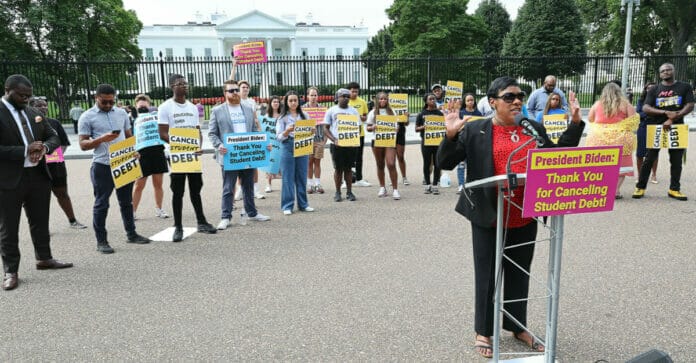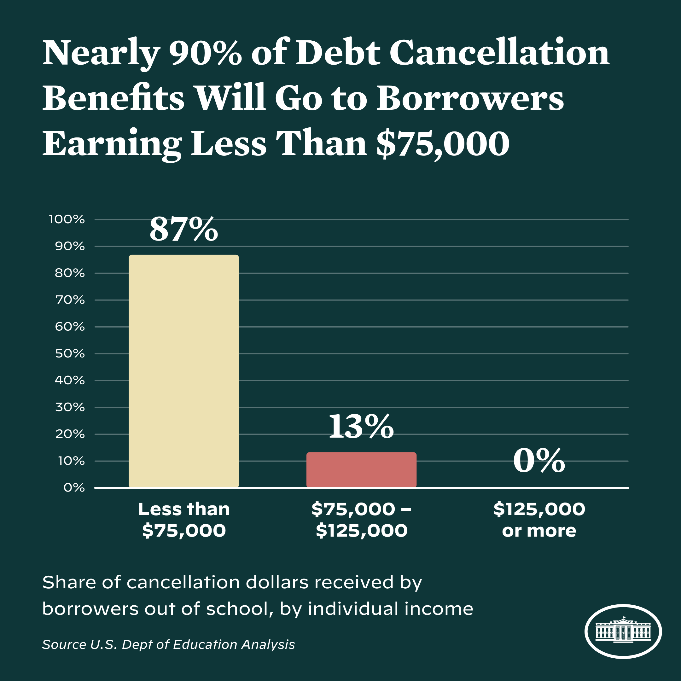
States Must Increase Funding, Hold More Bad Actors Accountable
By Charlene Crowell NNPA Newswire Columnist

President Joe Biden’s recent student debt cancellation announcement elicited a diverse range of reactions– some congratulatory, others critical, and still others that seem unsure what to make of the unprecedented multi-billion-dollar effort.
Predictably, long-time education and civil rights advocates spoke to the need for additional reforms, while others wondered about cancellation’s impact on an already troubled economy. Families struggling with the rising cost of living and deepening student debt –have only a few months to make household budget adjustments before loan payments resume in January.
The good news is that of the 43 million people affected by the executive action, 20 million borrowers will have all of their debt cancelled. Many of these borrowers incurred student loans but dropped out of school, left with thousands in debt and lower earnings due to the lack of a degree.
Another 27 million people from working class backgrounds who received Pell grants are assured of up to $20,000 in debt relief.
But these actions do not resolve the structural mismatch between the still-rising costs of college, limited family financial means to contribute to that cost, and the availability of financial aid other than interest-bearing loans.

“We’ve all heard of those schools luring students with a promise of big paychecks when they graduate only to watch these students be ripped off and left with mountains of debt,” stated President Biden on August 24. “Well, last week, the Department of Education fired a college accreditor that allowed colleges like ITT and Corinthian to defraud borrowers…Our goal is to shine a light on the worst actors so students can avoid these debt traps.”
It seems like a perfect time for the Department of Education to clean house of all the bad higher education actors — especially costly for-profit institutions that promise a lot but deliver little, and accreditors that fail to do their jobs.
On August 30, following President Biden’s announcement, the Department of Education took action against another defunct for-profit: Westwood College. This trade school lured unsuspecting students into costly debt from January 1, 2002 through November 17, 2015 when it stopped enrolling new borrowers in advance of its 2016 closure. The Department found widespread misrepresentations about the value of its credentials for attendees’ and graduates’ employment prospects.
“Westwood College’s exploitation of students and abuse of federal financial aid place it in the same circle of infamy occupied by Corinthian Colleges and ITT Technical Institute,” said Under Secretary James Kvaal. “Westwood operated on a culture of false promises, lies, and manipulation in order to profit off student debt that burdened borrowers long after Westwood closed.”
Now, 79,000 Westwood borrowers will benefit from $1.5 billion in debt cancellation, thanks to the Department.
Changes to Public Service Loan Forgiveness (PSLF) Program rules will allow borrowers that would not otherwise qualify, to receive credit for past periods of repayment. Interested borrowers and their families can get more information on the program’s information page, but they must act by October 31. Details on the time-limited offer are available at:https://studentaid.gov/announcements-events/pslf-limited-waiver.
But individual states must do their part as well. Across the nation, state revenues are flush with surpluses.
“I don’t think there’s been a time in history where states are better equipped to ride out a potential recession,” said Timothy Vermeer, senior state tax policy analyst at the Tax Foundation, a Washington, D.C.-based think tank. “A majority, if not all, of the rainy-day funds are in a really healthy position.”
Additionally, and according to the 2021 edition of the annual State Higher Education Finance (SHEF) report, short-changing higher education funding at the state level will likely lead to worse, not better results. The report tracks enrollment trends, funding levels and distributions of state institutions.
“Generous federal stimulus funding protected state revenues and directly supported higher education, reducing states’ need to cut funding during the pandemic and short economic recession,” states the report’s news release. “However, sharp declines in student enrollment and net tuition and fee revenue signal continued upheaval for public higher education revenues.”
Federal stimulus funding during the pandemic boosted state education appropriations, but only 8.9 percent of state aid to public institutions in 2021 went toward providing student financial aid, according to SHEF. And without federal stimulus funds, state education appropriations would have declined by one percent in 2021 if full-time enrollment had held constant, according to the report.
“States vary in their relative allocations to higher education,” states the report. “Public institutions in some states remain primarily publicly funded, but a growing proportion have become primarily reliant on student tuition and fee revenue over the last two decades.”
The report notes that while federal stimulus and relief funds are helpful, they cannot be a replacement for long-term state investments, because stimulus funds are time-limited and often restricted in their use.
If we want to end the student debt trap, now is the time for citizens to challenge states to use their tax revenue to do more for their own constituents.
Charlene Crowell is a senior fellow with the Center for Responsible Lending. She can be reached at Charlene.crowell@responsiblelending.org.

